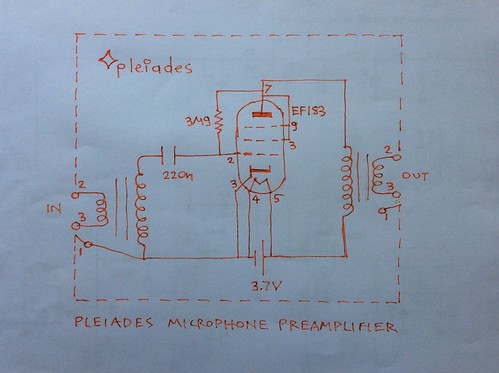The classic paper is:
Fluctuation Noise in Vacuum Tubes - G. L. Pearson
It can be found at archive.org
It describes the method of using 0 Ω in the input circuit, measuring the noise at the output and then increasing the input circuit resistance until noise is double.
This method is used by RCA to measure the noise performance of Nuvistors:
http://www.dtic.mil/dtic/tr/fulltext/u2/294926.pdf
(This report can be found in Google by searching with keywords one-half watt Nuvistor RCA)
On page 644 of the brilliant Pearson paper one can see the circuit used.
The grid of the electron tube to be tested is connected to a variable resistor the other side of which is connected to - battery and the + battery to ground.
Changing the variable resistor may change the grid bias or force the grid bias to some other potential possibly making errors in the measurements.
Why?
It has been shown by [Hammond et al] and relevant Pleiadss experiments that an internal bias of typically -700mV already exists just by supplying power to the heater. When the heated cathode emits electrons it becomes positive by cause of the missing electrons. Therefore the control grid becomes negative with respect to cathode.
So if we already have -700mV and a battery of 500mV is used as shown in the paper by using Kirchhoff's law (adding potentials), the potential of 700mV at the cathode is reduced to 200mV at the negative terminal of the battery. So when the variable resistor is rotated the grid voltage is forced to change. And of course we have external current from the grid back to the cathode. The missing electrons find a path to return to the cathode.
Kirchhoff's law says the some of all potentials around the closed circuit is 0.
So (assuming anode voltage has not been applied yet). 500mV + Igc x R must equal 700mV
So varying R we have a varying current. High values of this current which should lead to noise. In fact we try to force by a low resistance the open grid voltage of -700mV to become -500mV. Therefore a lot of current must flow.
On Pleiadss experiments this is avoided by connecting a capacitor is series with the grid. So the grid is left to assume it's own space potential. When a short circuit resistor is connected the very low impedance passes through the capacitor dramatically reducing tube noise but the electron tube control grid is not short circuited DC wise.
On the Pleiades experiments in order to make the electron tube operate at very low plate or anode voltage a high Megohm bias resistor (typically 6MΩ) is connected from anode to grid. It draws some electrons to the anode circuit and reduces the bias to say -50mV so it is then very easy for the electron tube to operate even with 4V at the anode. This is a way to change the grid potential but not by force as the pull-up potential is high and the external resistor is high of the order of megohms.
By using Ohm's law we can see that the external current from grid to anode is only a few μA. For example 6V reduced to almost 0 by a 6MΩ resistor requires just 1 μA.
The electron tube operates in an ultra low noise way. The anode voltage is very low. Therefore the heater voltage can be very low for saturating space charge. Anode current and transconductance is high. Plate resistance drops. Temperature emission effects from electrodes are minimized at such low temperature. Secondary emission of electrons, creation of positive ions is minimized too since the accelerating (low voltage) fields are very low.
When a short circuit is connected between cathode to ground or grid there is almost silence.
And the DC conditions of the electron tube are not disturbed since there is a film coupling capacitor.
This is the schematic of the Pleiades V6 microphone head amplifier

On the brilliant paper by Pearson on page 649 towards the end important information is given on the merits of operating a floating grid tube at a lower cathode temperature and with lower screen and plate voltage. This fact was pointed out by Dr. J. R. Dunning of Columbia University.
An interesting paper on open grid tube is the referenced one by Meyer.
And of course we have the brilliant design of Georg Neumann on the U47 VF14 head amplifier, approaching open grid condition, with low of the order of 40V anode potential and reduced cathode temperature by supplying it by typically 20 less volts. This microphone still plays a most important role in the history of contemporary recorded music.
References:
Fluctuation Noise in Vacuum Tubes - G. L. Pearson - (published in Physics September 1934) - Bell System Technical Journal
https://ia800308.us.archive.org/21/items/bstj13-4-634/bstj13-4-634.pdf
28-volt Operation of Receiving Tubes - C. R. Hammond, E. Kohler, W.J. Lattin - Electronics Magazine - Aug 1944
Open-grid Tubes in Low-Level Amplifiers - Robert J. Meyer - Electronics Magazine - October 1944
Neumann U47 schematic - The Neumann Microphone Type U 47 - BBC research department report No. M.020, SN 1954/23
http://downloads.bbc.co.uk/rd/pubs/reports/1954-23.pdf
On preserving transconductance of electron tubes at anode potential as low as 3 volts - euroelectron
Operating Features of the Audion - E. H. Armstrong
No comments:
Post a Comment